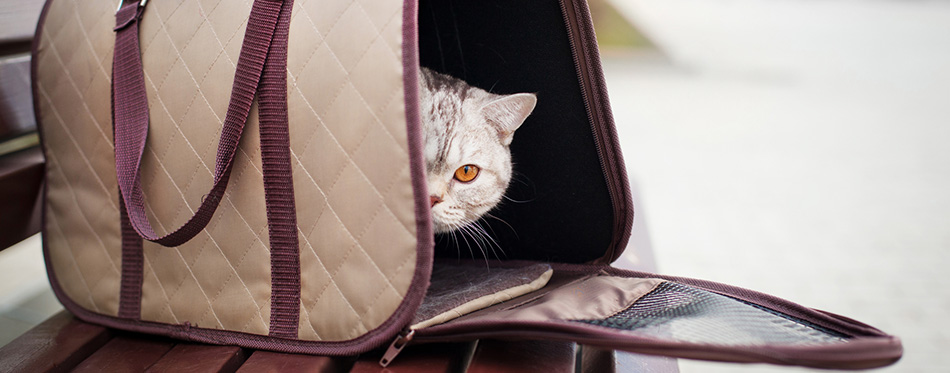Traveling with pets – and especially cats – can often be stressful. Unlike us, our feline companions can’t imagine something that never happened to them before; instead, they remember things that they experienced and anticipate them again. This can be an issue when you have to travel with your kit because most pets’ first car trips have to do with unpleasant vet visits, not comfy rides filled with road adventures. On top of this, most cats don’t like change; instead, they prefer the safety of their homes and routines. But if you’re moving or going on a vacation and have no one to take care of your pet, traveling with cats is inevitable. So how do you do this without stressing out your pet?
Here are some important things to know about cats, as well as tips and tricks on how to safely travel with one in tow.
Cats Are Sensitive to Change
As any experienced cat parent can tell you, cats hate major changes in their routine and environment. Whether there is a new person or an animal in a household, a sudden change in their feeding schedule, or a new thing they need to do (or even mustn’t do!), if a cat doesn’t like it – they will let you know. A study published in Live Science confirms this as it states that cats who are upset about a change in their environment let their owners know it. Unfortunately, since they can’t verbalize their displeasure, they “act out” by refusing to eat, vomiting excessively, not using their litter box, etc; basically, by playing sick even though they’re healthy. As you can imagine, moving or traveling counts as a disruptive change in a cat’s life. So how to travel with a cat without causing them to feel stressed and uncomfortable?
First of all, start slow. If your cat has never traveled by car before, it’s a good idea to introduce the car rides little by little. Go for short rides in the neighborhood with your cat in tow and let them see there’s nothing to fear. Better yet, before you go on your short rides, sit with your cat in the car for a while. This will ensure the change is gradual, and therefore easier to deal with for your kit.

Cats React Positively to Classical Conditioning
To add on the ‘slow but steady’ approach, try classical conditioning, also known as Pavlovian or respondent conditioning. This is a learning technique in which a biologically powerful stimulus like food is paired with a neutral stimulus like a bell, or in our case, a car. Basically, what you want to do is help your cat associate traveling by car with something positive. This is especially important if your cat is used to associating car rides with something negative like uncomfortable or painful vet visits, and is scared or hyper when you put them in the vehicle. Here is how you can go about this.
Again, start slow. Take your kitty and their favorite food or cat treats and stand near the car. Hold your cat and stroke them, speaking calmly and gently while getting closer to the car. If they start acting scared, give them a treat. Continue speaking calmly and petting your cat. Then, get in the car and do the same thing. The goal is to go for short rides and allow your pet to start associating them with something positive rather than negative. It will take some time and patience, but if you keep doing this, your cat will eventually learn to relax around and inside the car. It’s important you do this before traveling long distances.
Tips for Safe Cat Car Travel
Now that you’ve helped your cat associate car rides with something neutral or positive, it’s time to make traveling with your pet safe and comfortable. Following these tips will make traveling with cats in car a piece of cake.
- Consult With Your Vet
If your cat is particularly fearful, hyper or generally anxious around cars, and no amount of training seems to help, consider using a cat sedative for travel. Medication will sedate your cat and make traveling easier and less stressful for both of you, but it may not be a good option for all cats (e.g. cats with certain illnesses). To find out if your pet is a good fit for a sedative and also what the correct dosage is for their weight and how to administer it, talk to your vet. Do this well ahead of time you need it.
- Use a Carrier
For your and your cat’s safety, your kitty must be in a cat carrier while you’re driving the car. Riding with a loose pet is a recipe for disaster, as they can easily get underneath your brake pedal, start jumping at you, or even hop out of the window. In case of an accident, they also turn into a flying projectile, which is obviously something you want to avoid at all costs. Even the most well-behaved cats can cause trouble in a car or hurt themselves, so do make sure they are crated while riding. The crate should also be secured with a seat belt. This will keep both you and your pet safe, plus will help calm the nerves of anxious cats.
- Bring Your Cat’s Favorite Stuff
We mentioned that cats liking their routines and the safety of their homes. To make your cat as comfortable as possible during car rides, it’s a good idea to take a little bit of your home with you – your kitty’s favorite blanket, pillow or a cat toy (or all of it!) will make them feel more secure and safe. If you’re wondering how to travel long distance with a cat, this is it – by bringing your pet’s favorite stuff with you, you’ll ensure they’re calm and peaceful during the entire trip. Besides things that feel and smell like home, you should also take their usual litter, food and treats with you.
- Make Your Cat Feel Comfortable
If you bring your kitty’s favorite stuff with you, such as their blanket or a pillow, you’ll ensure they’re comfy in their crate, and as a result, quiet and peaceful during the entire ride. However, this only works if the trip is relatively short. Everything under six hours of traveling could be considered short, so your cat should be fine staying in the crate. If the trip is longer, say eight hours or more, you should let your cat out of the carrier occasionally– not only so they can stretch their legs a little, but also so they can go potty, drink water and have a meal. If your cat has a weak bladder or is diabetic or very old, you may want to let them out of the carrier more frequently (every four or so hours, depending on your cat’s health and age). The goal is to keep your kitty as comfortable as possible during the entire car ride.
- Don’t Leave Your Cat In The Car
If your trip is going to be a very long one, it’s logical you’ll want to get out of the car from time to time – to use the bathroom, eat, stretch your legs, etc. While this is of course a good idea, leaving your cat alone in the car while you’re outside doing your thing is not. Even if it doesn’t feel particularly hot outside, the temperature inside your vehicle can get dangerously high very quickly. To spare your cat from heat exhaustion, or worse yet, heatstroke, never leave them alone in the car. If you need to go out and eat, take your crated cat outside with you and eat together. The only time when it’s okay to leave a pet in the care alone is if you’re certain you won’t take longer than five minutes, e.g. when you have to use the restroom.
- Be Prepared for Trouble
Finally, it’s always a good idea to be prepared for trouble. Sometimes, no matter how hard we try to make everything work for both us and our furry companions, things can go wrong. Even with preparations and precautions, traveling with pets can be stressful. If you know that your cat hates change and traveling, it’s wise to prepare yourself – take extra treats with you to keep them happy, paper towels and cleaning supplies in case they throw up, and don’t forget to bring extra patience with you. Accept the fact that the first few trips with your cat may be stressful and longer than you’d like – whatever happens, it’s important to stay calm as this will help your kitty stay calm too.

Extra Tips:
- Make sure your cat has some sort of ID – a cat collar or a cat harness with your contact information or a microchip. While no one wants their cat to get lost, accidents happen and it’s good to be prepared.
- If your cat is hyperactive or suffers from motion sickness, don’t feed them the morning of your trip or during the car ride, unless it’s longer than six hours. This will minimize the risk of them vomiting.
- Take plenty of water with you but don’t leave a water bowl in the carrier while driving to avoid spills and messes. Give your cat water only when you are parked. For a wider selection of choices, check out our cat water bowl guide.
- If you’ll be staying at a hotel at some point, make sure it’s pet-friendly. You don’t want to get there and be turned away because of your cat, so confirm ahead of time that your hotel of choice allows pets.
Sources:
- How to Travel With Your Cat – Adventure Cats
- Travelling With Your Cat – International Cat Care

